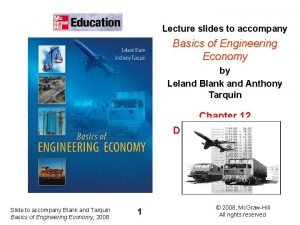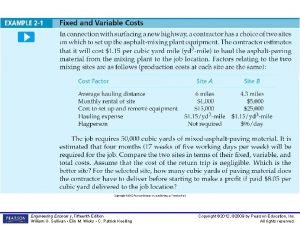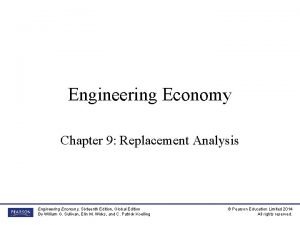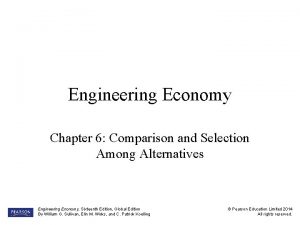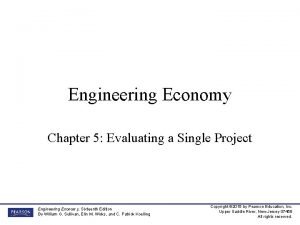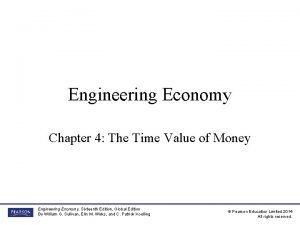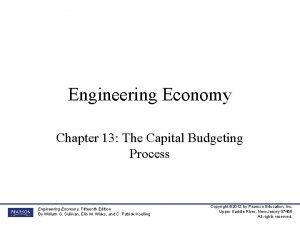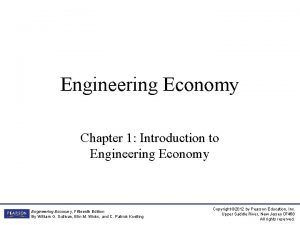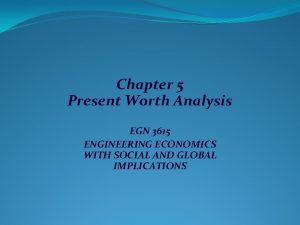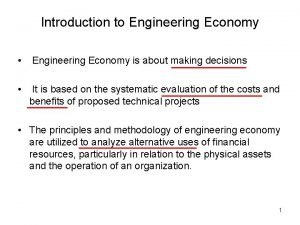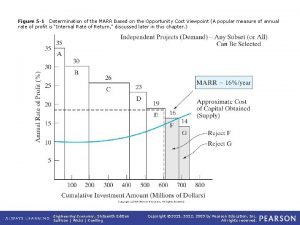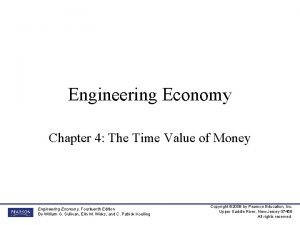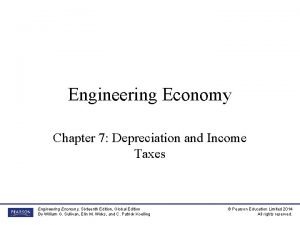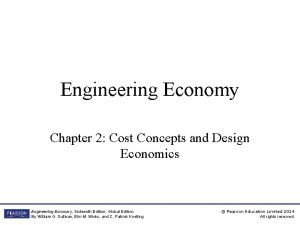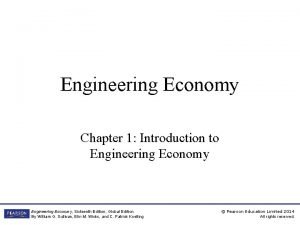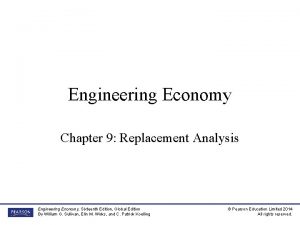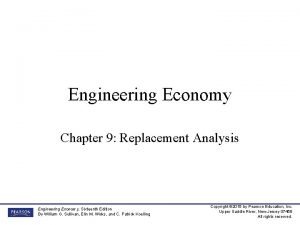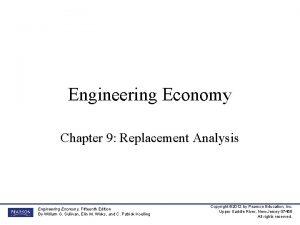Lecture slides to accompany Engineering Economy 8 th


























- Slides: 26

Lecture slides to accompany Engineering Economy, 8 th edition Leland Blank, Anthony Tarquin ©Mc. Graw-Hill Education. All rights reserved. Authorized only for instructor use in the classroom. No reproduction or further distribution permitted without the prior written consent of Mc. Graw-Hill Education.

Chapter 17 After-tax Economic Analysis ©Mc. Graw-Hill Education. All rights reserved. Authorized only for instructor use in the classroom. No reproduction or further distribution permitted without the prior written consent of Mc. Graw-Hill Education.

LEARNING OBJECTIVES 1. Terminology and rates; marginal tax tables 2. Determining cash flows before taxes(CFBT) and after taxes (CFAT) 3. Effects of depreciation on taxes 4. Depreciation recapture and capital gains 5. Performing an after-tax analysis 6. Performing after-tax replacement studies 7. Economic value-added analysis 8. Tax structures outside the United States 9. Understanding value-added tax (VAT) ©Mc. Graw-Hill Education.

Income Tax Terms and Relations (Corporations) Income taxes are real cash flow payments to governments levied against income and profits. The (noncash) allowance of asset depreciation is used in income tax computations. • • Note: All terms and relations are calculated for each year t, but the subscript is often omitted for simplicity ©Mc. Graw-Hill Education.

Tax Terms and Relations – Corporations • ©Mc. Graw-Hill Education.

US Corporate Federal Tax Rates - 2010 If Taxable Income (TI) is: Over, $ But not over, $ Tax is, $ and % Of the amount over, $ 15% 0 0 50, 000 75, 000 100, 000 335, 000 10, 00 0 15, 000 10, 000 15, 000, 00 18, 333 US rates provide 0 a slight tax advantage for small businesses 18, 333, 33 Rates are an effective 34%No forlimit TI > 3 flat at 35% for TI > $335, 000 and $18. 33 M ©Mc. Graw-Hill Education. 15, 000 Income tax rates are graduated or progressive as TI increases Each rate bracket is the marginal tax 35% rate for the TI range 0

Average and Effective Tax Rates • ©Mc. Graw-Hill Education.

Example: Income Tax Calculations Annual operating revenue is $1. 2 million with expenses of $0. 4 million and $350, 000 depreciation on assets. The state imposes a flat rate of 5% of all TI. Determine (a) actual taxes and (b) approximate taxes using Te. • Approximation underestimate s actual by 4. 4% ©Mc. Graw-Hill Education.

Income Taxes for Individuals • ©Mc. Graw-Hill Education.

Cash Flow After Taxes (CFAT) • A negative TI value is considered a tax savings for the project Once CFAT series is determined, economic evaluation using any method is performed the same as before taxes, now using estimated CFAT values ©Mc. Graw-Hill Education.

Effects on Taxes of Depreciation Method and Recovery Period Goal is to minimize PW of taxes, which is equivalent to maximizing PW of depreciation • RECOVERY PERIOD All lengths have the same amount of total taxes due Shorter recovery periods result in lower PWtaxes General goal: use shortest (MACRS) recovery period allowed (Note: with same single tax rate, depreciation method and salvage value) ©Mc. Graw-Hill Education.

Depreciation Recapture (DR) and Capital Gain (CG) and Capital Loss (CL) • • • ©Mc. Graw-Hill Education.

Effects of DR, CG and CL on TI and Taxes • • ©Mc. Graw-Hill Education.

Example: Depreciation Recapture • • • ©Mc. Graw-Hill Education.

After-Tax Evaluation • ©Mc. Graw-Hill Education.

Approximating After-Tax ROR Value • • ©Mc. Graw-Hill Education.

Example: After-Tax Analysis • • ©Mc. Graw-Hill Education.

After-Tax Replacement Analysis Consider depreciation recapture (DR) or capital gain (CG), if challenger is selected over defender Can include capital loss, if trade occurs at very low (‘sacrifice’) trade-in for defender An after-tax analysis can reverse the selection compared to before-tax analysis, but more likely it will provide information about differences in PW, AW or ROR value when taxes are included Apply same procedure as before-tax replacement evaluation once CFAT series is estimated ©Mc. Graw-Hill Education.

Example: Before- and After-Tax Replacement Study • S O L U T I O N Select defender both ©Mc. Graw-Hill Education.

Economic Value Added (EVA)TM Analysis Definition: The economic worth added by a product or service from the perspective of the consumer, owner or investor In other words, it is the contribution of a capital investment to the net worth of a corporation after taxes Example: The average consumer is willing to pay significantly more for potatoes processed and served at a fast-food restaurant as fries (chips) than as raw potatoes in the skin from a supermarket. Value-added analysis is performed in a different way than CFAT analysis, however… Selection of the better economic alternative is the same for EVA and CFAT analysis, because it is always correct that … • ©Mc. Graw-Hill Education.

EVA Analysis: Procedure DIFFERENCE BETWEEN CFAT AND EVA APPROACHES • CFAT estimates (describes) how actual cash will flow • EVA estimates extra worth that an alternative adds • EVA is a measure of worth that mingles actual cash flows and noncash flows • • ©Mc. Graw-Hill Education.

International Tax Structures Tax related questions for internationally located projects concentrate on items such as: • • • Depreciation methods approved by host country Capital investment allowances Business expense deductibility Corporate tax rates Indirect tax rates – Value-Added Tax and Goods and Service Tax (VAT/GST) Rules and laws vary considerably from country to country ©Mc. Graw-Hill Education.

Summary of International Corporate Tax Rates Tax Rate Levied on TI, % For These Countries United States, Japan Pakistan, Sri Lanka France, India, South Africa Australia, United Kingdom, Canada, New Zealand, Spain, Germany, Mexico China, Indonesia, South Korea, Israel Russia, Turkey, Saudi Arabia Singapore, Hong Kong, Taiwan, Chile, Ireland, Iceland, Hungary Source: KPMG Corporate and Indirect Tax Rate Survey, 2010 ©Mc. Graw-Hill Education.

Value-Added Tax (VAT) VAT is an indirect tax placed on goods and services, not on people and corporations like an income tax. The VAT is charged sequentially throughout the process of manufacturing a good or providing a service. The VAT is also called Goods and Service Tax (GST). VAT CHARACTERISTICS A percent, e. g. , 10%, of current value, of unfinished goods or service (G/S) is charged to the purchaser and sent to taxing entity by manufacturer or provider VAT charged to buyer at purchase time whether buyer is an end user or intermediate business As next transfer occurs, VAT previously paid on unfinished G/S is subtracted from VAT currently due ©Mc. Graw-Hill Education. SALES TAX CHARACTERISTICS Charged only once at final product sale to the end user or consumer Selling merchant sends tax to taxing entity Businesses do not pay sales tax on raw materials or unfinished goods or service Businesses do pay sales tax on items

Example: How a 10% VAT Could Work in the US • ©Mc. Graw-Hill Education.

Summary of Important Points For a corporation’s taxable income (TI), operating expenses and asset depreciation are deductible items Income tax rates for corporations and individuals are graduated by increasing TI levels CFAT indirectly includes (noncash) depreciation through the TI computation Depreciation recapture (DR) occurs when an asset is sold for more than the book value; DR is taxed as regular income in all after-tax evaluations After-tax analysis uses CFAT values and the same guidelines for alternative selection as before-tax analysis EVA estimates extra worth that an alternative adds to net worth after taxes; it mingles actual cash flows and noncash flows A VAT system collects taxes progressively on unfinished goods and ©Mc. Graw-Hill Education.
 Hebrews 6:9-12 sermon
Hebrews 6:9-12 sermon Accompany chapter 1
Accompany chapter 1 Interpectoral lymph node
Interpectoral lymph node Inkjet printers are considered legacy technology
Inkjet printers are considered legacy technology Athens vs sparta differences
Athens vs sparta differences A small child slides down the four frictionless slides
A small child slides down the four frictionless slides A hockey puck sliding on smooth ice at 4 m/s
A hockey puck sliding on smooth ice at 4 m/s Principles of economics powerpoint lecture slides
Principles of economics powerpoint lecture slides Machine learning lecture slides
Machine learning lecture slides Business communication lecture slides
Business communication lecture slides 01:640:244 lecture notes - lecture 15: plat, idah, farad
01:640:244 lecture notes - lecture 15: plat, idah, farad Engineering economy
Engineering economy Dressler
Dressler Engineering economy
Engineering economy Comparison and selection among alternatives
Comparison and selection among alternatives Engineering economy 16th edition solution manual chapter 5
Engineering economy 16th edition solution manual chapter 5 Engineering economy 16th edition chapter 4 solutions
Engineering economy 16th edition chapter 4 solutions Engineering economy
Engineering economy Develop the alternatives engineering economy
Develop the alternatives engineering economy Present worth analysis
Present worth analysis Introduction to engineering economy
Introduction to engineering economy Engineering economy
Engineering economy Engineering economy chapter 4 solutions
Engineering economy chapter 4 solutions Engineering economy 16th edition solution manual chapter 5
Engineering economy 16th edition solution manual chapter 5 Engineering economy 16th edition solution
Engineering economy 16th edition solution Pearson engineering
Pearson engineering Engineering economy 16th edition chapter 1 solutions
Engineering economy 16th edition chapter 1 solutions











